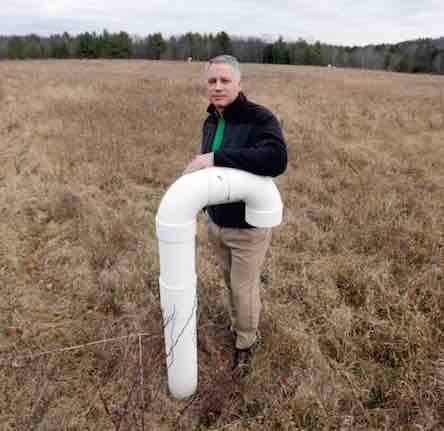The decision by Nassau to rely on solar, wind, landfill gas and battery storage by 2020 puts the town of 5,000 near Albany on the leading edge of a national campaign to develop “microgrids” designed to make communities more energy independent.
Nassau began its journey to energy independence when ice storms that knocked out power in 2008 and 2009. They knew they needed microgrids when front-end loaders opened the heavy highway department doors so sand trucks could get on the road. A small generator couldn’t handle the lift, town Supervisor David Fleming told media.
“The town found itself in a vulnerable position when the aging infrastructure would fail,” Fleming said. The planned renewable energy switch will cover the town hall, the highway garage, and police and fire departments. A committee has been formed to refine the plan and figure out its costs.
“Campus microgrids” are familiar at places like hospitals and industrial plants. Development of the more sprawling “community microgrids” has been slowed by technical and regulatory hurdles. There’s also been a mixed response from utility companies. Some see it as a threat to their franchise; others embrace microgrids as a business opportunity.
That puts Fairfield, Connecticut, ahead of the curve. A year ago, it hooked up an off-the-grid system that automatically takes over if the utility grid fails. Inspired by Superstorm Sandy, which left much of the town of 59,000 without power for as long as nine days, the new system has yet to be tested in a storm.
Built with the help of a $1.1 million state program, Fairfield’s system combines a natural gas-powered generator and solar panels at the emergency shelter and fire station. The system connects the fire station and emergency shelter to the police station and cellphone towers. A similar system is in the works at Fairfield’s waste water treatment plant.
Unlike Nassau’s plan, Fairfield remains connected to the grid and sells excess power back to its utility company.
“It’s a good deal for us,” said Ed Boman, the assistant public works director. He said there are also savings from heating and cooling the police station with waste heat from a natural gas generator.
Michael Burr is founder and director of the Minnesota-based consultancy Microgrid Institute. He is involved in projects in New York and Maryland, where the Montgomery County town of Olney is participating in a $1.2 million federal Department of Energy project to design and test microgrid control systems.
Burr said there is strong interest in increasing reliance on renewable energy and reducing reliance on fossil fuels. And some communities see value in using locally-generated power to bolster their economies.
In New York, the state is reviewing 83 proposals in the first round of a $40 million program to jumpstart microgrids, with a group of finalists for further review expected to be announced this summer. And a key part of the state’s larger renewable energy effort involves regulated utilities.
“New York is very focused on getting the utilities on board,” said John Rhodes, president and CEO of the New York Energy Research and Development Authority. Part of that involves changing regulations “so they have more incentives to do things that are good for the system at large.”
The immediate goal, Rhodes said, is helping fund “a pipeline of high-quality projects” in 2017 that will promote more interest in microgrids.
powkey Portable Power Station 350W, 260Wh/70,000mAh Backup Lithium Battery, 110V Pure Sine Wave Power Bank with 2 AC Outlets, Portable Generator for Outdoors Camping Travel Hunting Emergency
Now retrieving the rating.
$192.98 (as of April 18, 2024 14:24 GMT +01:00 - More infoProduct prices and availability are accurate as of the date/time indicated and are subject to change. Any price and availability information displayed on [relevant Amazon Site(s), as applicable] at the time of purchase will apply to the purchase of this product.)200W Portable Power Station, Powkey 120Wh/33,000mAh Power Bank with AC Outlet, 110V 6 Outputs Solar Generator External Battery Pack with LED Light for Home Use and Outdoor Camping
Now retrieving the rating.
31% OffPortable Power Station 600W, Powkey 296Wh Battery Backup with 2 Pure Sine Wave AC Outlets, USB-C PD100W and 2 Wireless Chargers, Solar Generator (Solar Panel Optional) for Outdoor Camping/RVs/Home Use
Now retrieving the rating.
10% OffFoldable Solar Panel Charger 60W with 18V DC Output (11 Connectors) for 100W~350W Portable Power Stations Jackery/Rockpals/Flashfish/Enginstar, Portable Solar Generator for Outdoor Camping Van RV Trip
Now retrieving the rating.
$98.99 (as of April 18, 2024 14:24 GMT +01:00 - More infoProduct prices and availability are accurate as of the date/time indicated and are subject to change. Any price and availability information displayed on [relevant Amazon Site(s), as applicable] at the time of purchase will apply to the purchase of this product.)10W USB LED Light for Camping Garage Warehouse Car Truck Fishing Boat Outdoor Portable Bulb, Emergency Light, Children Bed Lamp
Now retrieving the rating.
$9.99 (as of April 18, 2024 14:24 GMT +01:00 - More infoProduct prices and availability are accurate as of the date/time indicated and are subject to change. Any price and availability information displayed on [relevant Amazon Site(s), as applicable] at the time of purchase will apply to the purchase of this product.)






